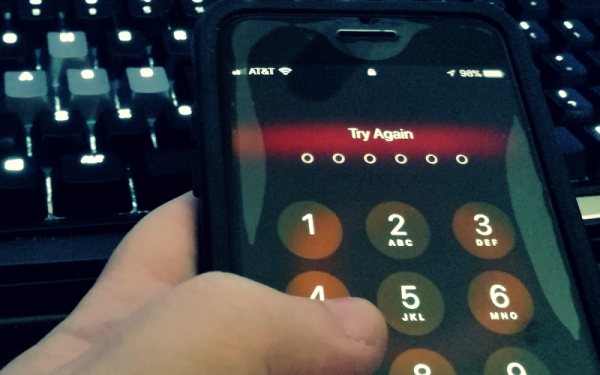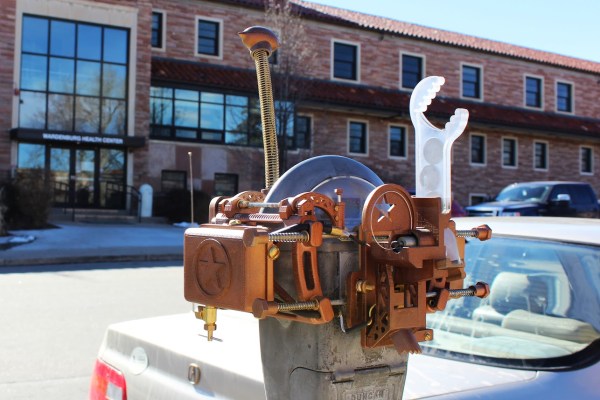After a quiet week in the news cycle, surveillance concern Flock jumped right back in with both feet, announcing a strategic partnership with Amazon’s Ring to integrate that company’s network of doorbell cameras into one all-seeing digital panopticon. Previously, we’d covered both Flock’s “UAVs as a service” model for combating retail theft from above, as well as the somewhat grassroots effort to fight back at the company’s wide-ranging network of license plate reader cameras. The Ring deal is not quite as “in your face” as drones chasing shoplifters, but it’s perhaps a bit more alarming, as it gives U.S. law enforcement agencies easy access to the Ring Community Request program directly through the Flock software that they (probably) already use.
law enforcement7 Articles
A Deep Dive On Creepy Cameras
George Orwell might’ve predicted the surveillance state, but it’s still surprising how many entities took 1984 as a how-to manual instead of a cautionary tale. [Benn Jordan] decided to take a closer look at the creepy cameras invading our public spaces and how to circumvent them.
[Jordan] starts us off with an overview of how machine learning “AI” is used Automated License Plate Reader (ALPR) cameras and some of the history behind their usage in the United States. Basically, when you drive by one of these cameras, an ” image segmentation model or something similar” detects the license plate and then runs optical character recognition (OCR) on the plate contents. It will also catalog any bumper stickers with the make and model of the car for a pretty good guess of it being your vehicle, even if the OCR isn’t 100% on the exact plate sequence.
Where the video gets really interesting is when [Jordan] starts disassembling, building, and designing countermeasures to these systems. We get a teardown of a Motorola ALPR for in-vehicle use that is better at being closed hardware than it is at reading license plates, and [Jordan] uses a Raspberry Pi 5, a Halo AI board, and You Only Look Once (YOLO) recognition software to build a “computer vision system that’s much more accurate than anything on the market for law enforcement” for $250.
[Jordan] was able to develop a transparent sticker that renders a license plate unreadable to the ALPR but still plainly visible to a human observer. What’s interesting is that depending on the pattern, the system could read it as either an incorrect alphanumeric sequence or miss detecting the license plate entirely. It turns out, filtering all the rectangles in the world to find just license plates is a tricky problem if you’re a computer. You can find the code on his Github, if you want to take a gander.
You’ve probably heard about using IR LEDs to confuse security cameras, but what about yarn? If you’re looking for more artistic uses for AI image processing, how about this camera that only takes nudes or this one that generates a picture based on geographic data?
Hackaday Links: August 24, 2025
“Emergency Law Enforcement Officer Hologram program activated. Please state the nature of your criminal or civil emergency.” Taking a cue from Star Trek: Voyager, the Seoul Metropolitan Police Agency is testing a holographic police officer, with surprisingly — dare we say, suspiciously? — positive results. The virtual officer makes an appearance every two minutes in the evening hours in a public park, presumably one with a history of criminal activity. The projection is accompanied by a stern warning that the area is being monitored with cameras, and that should anything untoward transpire, meat-based officers, presumably wearing something other than the dapper but impractical full-dress uniform the hologram sports, will be dispatched to deal with the issue.
Sufficiently Advanced Technology And Justice
Imagine that you’re serving on a jury, and you’re given an image taken from a surveillance camera. It looks pretty much like the suspect, but the image has been “enhanced” by an AI from the original. Do you convict? How does this weigh out on the scales of reasonable doubt? Should you demand to see the original?
AI-enhanced, upscaled, or otherwise modified images are tremendously realistic. But what they’re showing you isn’t reality. When we wrote about this last week, [Denis Shiryaev], one of the authors of one of the methods we highlighted, weighed in the comments to point out that these modifications aren’t “restorations” of the original. While they might add incredibly fine detail, for instance, they don’t recreate or restore reality. The neural net creates its own reality, out of millions and millions of faces that it’s learned.
![]() And for the purposes of identification, that’s exactly the problem: the facial features of millions of other people have been used to increase the resolution. Can you identify the person in the pixelized image? Can you identify that same person in the resulting up-sampling? If the question put before the jury was “is the defendant a former president of the USA?” you’d answer the question differently depending on which image you were presented. And you’d have a misleading level of confidence in your ability to judge the AI-retouched photo. Clearly, informed skepticism on the part of the jury is required.
And for the purposes of identification, that’s exactly the problem: the facial features of millions of other people have been used to increase the resolution. Can you identify the person in the pixelized image? Can you identify that same person in the resulting up-sampling? If the question put before the jury was “is the defendant a former president of the USA?” you’d answer the question differently depending on which image you were presented. And you’d have a misleading level of confidence in your ability to judge the AI-retouched photo. Clearly, informed skepticism on the part of the jury is required.
Unfortunately, we’ve all seen countless examples of “zoom, enhance” in movies and TV shows being successfully used to nab the perps and nail their convictions. We haven’t seen nearly as much detailed analysis of how adversarial neural networks create faces out of a scant handful of pixels. This, combined with the almost magical resolution of the end product, would certainly sway a jury of normal folks. On the other hand, the popularity of intentionally misleading “deep fakes” might help educate the public to the dangers of believing what they see when AI is involved.
This is just one example, but keeping the public interested in and educated on the deep workings and limitations of the technology that’s running our world is more important than ever before, but some of the material is truly hard. How do we separate the science from the magic?
All Your IPhone Are Belong To Us
Apple’s commitment to customer privacy took the acid test after the San Bernadino shooting incident. Law enforcement demanded that Apple unlock the shooter’s phone, and Apple refused. Court cases ensued. Some people think that the need to protect the public outweighs the need for privacy. Some people think that once they can unlock one iPhone, it won’t stop there and that will be bad for everyone. This post isn’t about either of those positions. The FBI dropped their lawsuit against Apple. Why? They found an Israeli firm that would unlock the phone for about $5,000. In addition, Malwarebytes — a company that makes security software — reports that law enforcement can now buy a device that unlocks iPhones from a different company.
Little is known about how the device — from a company called Grayshift — works. However, Malwarebytes has some unverified data from an unnamed source. Of course, the exploit used to break the iPhone security is secret because if Apple knew about it, they’d fix it. That’s happened before with a device called IP-box that was widely used for nefarious purposes.
Auto-Meter Reader Feeder Keeps Meter-Maids At Bay
Planting your car just about anywhere almost always comes at a price; and, if you’re overdue for your return, odds are good that you’ll end up paying a much steeper price than intended. Parking meters are wonderful devices at telling the authorities just how much time you have left until you’re ticketworthy. [Zack] figured that five–even ten minutes late—is an absurd reason to pay a fine, so he’s developed a tool that will preload a meter with a few extra coins when the authorities get too close.
The law-enforcement detection system puts together of number of tools and techniques that we’re intimately familiar with: 3D printing, Arduino, a photoresistor, and a proximity (PIR) sensor. At the code level, [Zack] filters his analog photo resistor with a rolling average to get a clean signal that triggers both by day and by night. The trigger? Two possibilities. The PIR sensor detects curious law enforcement officers while the filtered photoresistor detects the periodic twirling siren lights. Both events will energize a solenoid to drop a few extra coins through a slide and into the meter slot.
For a collection of well-known components, [Zack] could’ve packed his contraption into a Altoids Tin and called it a day. Not so. As an interaction designer, looks could make or break the experience. For this reason, he opts for a face-hugging design with a steampunk twist. Furthermore, to achieve compatibility across a range of devices, [Zack’s] CAD model is the result of adjusting for various meter profiles from images he snapped in the urban wilderness. The result? A clean, authentic piece of equipment compatible with a family of meters.
For the shrewd-eyed observers, [Zack’s] first video post arrived online in 2011, but his work later resurfaced at a presentation in the 2015 Tangible, Embedded, and Embodied Conference by his former design instructor [Eric Paulos], who was eager to show off [Zack’s] work. For a deeper dive into the upcoming second edition, head on over to [Zack’s] image feed.
Continue reading “Auto-Meter Reader Feeder Keeps Meter-Maids At Bay”
Mexican Law Enforcement Seizes A Hacked Together Weed Cannon

Here’s an interesting hack. It’s a small pick-up truck with a Dope Cannon attached to it. Sure, it looks more like something you’d see in Syria, but this item was actually seized in Mexico where it was being used to fire 30 pound slugs of Marijuana over the border fence with the US. Usually when you fire artillery there isn’t someone on the target range trying to recover the projectile!
The device uses a PVC barrel to guide the pot-pellet as it’s propelled by compressed air. Hey, swap out the drugs for an energy drink and that sounds pretty familiar. Our qualifying entry for the 2012 Red Bull Creation Contest was an energy drink cannon which used the same setup with a slightly smaller caliber. It makes us wonder if the drug cartel uses little parachutes like we did?
Doesn’t it arouse suspicion to drive something like this around town? You’d think they’d use a box truck or something similar to hide the giant gun.
[Photo Credit: AP via NY Daily News]
[via Reddit]















